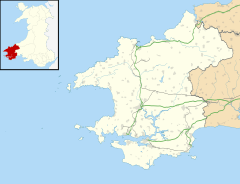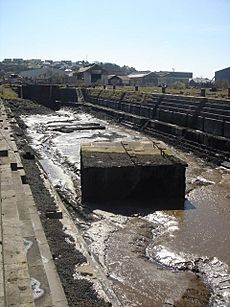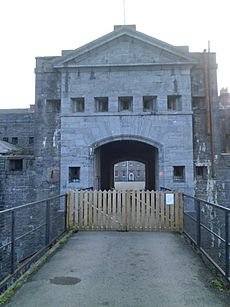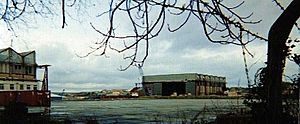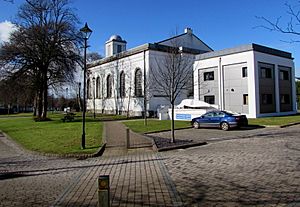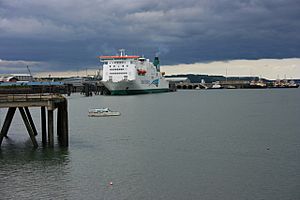Pembroke Dock facts for kids
Quick facts for kids Pembroke Dock
|
|
|---|---|
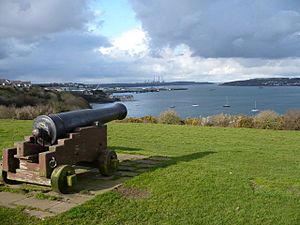 Pembroke Dock and Cleddau Estuary |
|
| Population | 9,753 (2011) |
| OS grid reference | SM965035 |
| Community |
|
| Principal area | |
| Ceremonial county | |
| Country | Wales |
| Sovereign state | United Kingdom |
| Post town | PEMBROKE DOCK |
| Postcode district | SA72 |
| Dialling code | 01646 |
| Police | Dyfed-Powys |
| Fire | Mid and West Wales |
| Ambulance | Welsh |
| EU Parliament | Wales |
| UK Parliament |
|
Pembroke Dock (Welsh: Doc Penfro) is a busy town in Pembrokeshire, South West Wales. It's located about 3 miles (5 km) northwest of Pembroke, right on the banks of the River Cleddau.
The town was originally a small fishing village called Paterchurch. It grew very quickly after the Royal Navy Dockyard was built there in 1814. Today, the Cleddau Bridge connects Pembroke Dock with the town of Neyland. After Haverfordwest and Milford Haven, Pembroke Dock is the third-largest town in Pembrokeshire.
Contents
History of Pembroke Dock
The natural harbour here, now called the Milford Haven Waterway, has been used for thousands of years. It offers great shelter from strong winds. The name of the Carr Rocks at the entrance comes from the Norse word Skare, meaning rock. This shows that Norse people, like the Vikings, visited the area.
From 790 AD until the Norman Invasion in 1066, Vikings used the estuary. A Viking leader named Hubba even spent a winter here with 23 ships around 854 or 878 AD.
In 1172, King Henry II's fleet and army got ready here before sailing to Ireland during the Norman Invasion of Ireland.
From Paterchurch to a New Town
Before 1814, the area was mostly farmland known as Paterchurch. The first mention of Paterchurch was in 1289. A medieval tower was built there, likely used as a lookout post. By the 17th century, other buildings and a cemetery were near the tower. The ruins of this tower are now inside the dockyard walls.
The land changed hands over the years, with the Meyrick family eventually owning most of the area where the dockyard and new town would be built. By 1802, the Paterchurch buildings were mostly ruins.
World War II Bombing
During the Second World War, Pembroke Dock was a target for German planes, called the Luftwaffe. On August 19, 1940, a German bomber attacked oil tanks at Pennar. The fire from the oil burned for 18 days! It was one of the biggest fires in the UK since the Great Fire of London.
More bombing happened on May 11 and 12, 1941. This attack killed 30 people and injured many more. Nearly 2,000 houses in the town were damaged.
The idea of building ships here started long ago. In 1757, the British Navy looked at the Milford Haven Waterway as a good place for a dockyard.
Early Dockyard at Milford Haven
Shipbuilding first began on the north side of the waterway. A private shipyard was leased by the Navy. In 1809, the Navy decided to buy the facility and make it a formal Royal Navy dockyard. After the Napoleonic Wars, it was planned to be a model dockyard.
Founding Pembroke Dockyard
The Navy couldn't agree on a price for the Milford shipyard. So, they decided to buy land about 5 miles (8 km) across the harbour, near Pembroke. This area, called Pater or Paterchurch, was perfect for building large ships because the shoreline was flat but led to deep water.
The town of Pembroke Dock was officially started in 1814 when the Pembroke Dockyard was built. It was first called Pater Dockyard. Construction began right away. The first ships were launched on February 10, 1816.
Ships Built and Closure
Over 112 years, the dockyard built 263 Royal Navy vessels, including five royal yachts. The very last ship launched from the dockyard was the Oleander on April 26, 1922.
In 1925, it was announced that the Pembroke Dockyard would close. People protested, saying there would be no jobs, but the decision was not changed. The dockyard officially closed in 1926.
What Happened After
Even though the dockyard closed in 1926, the site remained important to the Navy for many years. The Ministry of Defence sold the land to the Milford Haven Port Authority in 2007.
Future Plans
In 2021, plans were approved to change Pembroke Dock's historic dockyard into a marine energy project. This £60 million project aims to bring new industry to the area. Some historic buildings will be changed or replaced, but the goal is to create new jobs and opportunities.
Military Garrison
As the dockyard grew, it needed protection. Pembroke Dock became a military town. Work began in 1844 to build defensible barracks. The Royal Marines were the first to live there in 1845.
Between 1849 and 1857, two Martello towers were built to defend the dockyard. Later, in 1904, new barracks called Llanion Barracks were built to house a thousand troops. These were very modern for their time. Troops stayed in the town until 1967.
RAF Base
After the dockyard closed in 1926, unemployment was high. But in 1931, the Royal Air Force (RAF) arrived with their flying boats. For almost 30 years, Pembroke Dock was an RAF base. In 1943, it was the largest base for flying boats in the world, home to the Sunderland flying boats.
The RAF started reducing its presence in 1957. Pembroke Dock also has a cool link to Hollywood: the full-size Millennium Falcon from The Empire Strikes Back was built in one of Pembroke Dock's hangars in 1979!
Pembroke Dock Today
Pembroke Dock is connected by the A477 trunk road. This road crosses the Daugleddau estuary on the Cleddau Bridge.
The town has a ferry terminal where Irish Ferries sail twice a day to Rosslare in Ireland. There's also a deep-water cargo port nearby. The Pembroke Dock railway station connects the town to Carmarthen and Tenby.
Historic Buildings and Sites
- The two Martello towers are still standing. One used to be a museum.
- The original dockyard wall is mostly complete and has been repaired.
- The dry dock and two of the ten building slips also remain.
- Two large hangars, built for the Sunderland flying boats, have been rebuilt and are used for other things.
- The Terrace, a row of houses for dockyard officers, is still there.
- The Dockyard Chapel has been rebuilt and is now the Pembroke Dock Heritage Centre.
Some buildings from the old Llanion Barracks also remain. The Officers' and Sergeants' Mess is now used by Pembrokeshire Coast National Park. The old guardroom is now a home, and a historic Powder Magazine is set into the hillside.
Cemeteries
The town has two cemeteries with many graves of service personnel.
- Pembroke Dock (Llanion) Cemetery has war graves from both the First World War and the Second World War.
- Pembroke Dock Military Cemetery is believed to be the only dedicated military cemetery in Wales. It also holds war graves from both World Wars.
Modern Developments
The Pembrokeshire Technium, a technology center, opened in 2006. There are also plans for a new yacht marina to be built alongside Front Street.
Famous People from Pembroke Dock
Many interesting people have come from Pembroke Dock, including:
- Brigadier General Henry Stanhope Sloman (1861–1945), a senior British Army officer.
- John Harper Narbeth (1863–1944), a naval architect.
- Sir John Blake-Reed (1882–1966), a British judge.
- Ernie Finch (1899-1983), a Welsh international rugby player.
- Colin George (1929–2016), a Welsh actor and director.
- Phil Carradice (born 1947), a Welsh writer and broadcaster.
- Andy Goddard (born 1968), a Welsh director and screenwriter.
- Taliesin Selley (born 1980), a Welsh former rugby player.
Renaming Ideas
Sometimes, people have suggested changing Pembroke Dock's name to improve its image. Ideas have included Pembroke Haven or Pembroke Harbour, or even going back to its original name, Paterchurch. However, the town has voted against changing the name in the past.
How Pembroke Dock is Governed
Pembroke Dock has two levels of local government:
- Pembroke Dock Town Council: This council has 16 councillors and helps manage local town matters.
- Pembrokeshire County Council: This council handles bigger issues for the whole county.
The town is divided into four areas for county council elections: Pembroke Dock Central, Pembroke Dock Llanion, Pembroke Dock Market, and Pembroke Dock Pennar. Each area elects one county councillor.
History of Local Government
Pembroke Dock was once part of the ancient borough of Pembroke. In 1986, Pembroke was split into two separate communities: Pembroke Dock and Pembroke. This was the first time Pembroke Dock had its own separate local council.
Freedom of the Town
HMS Pembroke, a ship of the Royal Navy, was given the Freedom of the Town of Pembroke Dock on September 15, 2006. This is a special honour given to military units.
See also
 In Spanish: Pembroke Dock para niños
In Spanish: Pembroke Dock para niños


